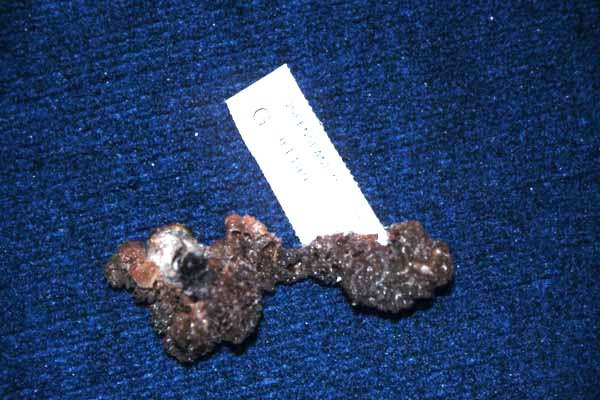Morphological description (show/hide)
| Gross morphology is more-or-less tubulo-digitate, variable in size, ranging from small single digits (8 cm high) to massive multiple lobes attached to a common base (45 cm high), composed of lamellate, cavernous, insubstantial, tight or loosely anastomosing branches. Growth form is characteristic and relatively consistent, but the surface may or may not have small digitate processes arising from free branches. Where present, surface processes range from tapering digitate to spiny protrusions. | | When pigmentation is present, it is relativel | | Pores are usually flush with the surface, or raised only slightly above it, with a distinct membranous lip. Oscules are scattered between surface conules, not confined to any particular region, and they measure between 0.4 - 2.2 mm in diameter. | | The surface is moderately dense to very dense, ornamented by minute grooves and striations and irregularly scattered microconulose processes (e.g. Plate 2 B). The whole surface is irregularly folded as a result of the tubular habit and cavernous construction. In places the dermal membrane is stretched across adjacent branches, through which subdermal canals can be seen. | | The choanosomal skeleton consists of a regular to subisodictyal reticulation, produced by ascending primary fibres (60-135 ï¾µm) and transverse connecting fibres (25-39 ï¾µm in diameter), which form rectangular to square meshes lined by oval choanocyte chambers (22-180 ï¾µm). Fibres are heavily invested with spongin, less often light, and the ascending or longitudinal primary elements are cored by multispicular tracts of both choanosomal principal and subectosomal auxiliary megascleres. Fibres have a tendency to become heavier in the axis than towards the periphery. Coring spicules occupy less than 66% of primary fibre diameter, whereas connecting fibres are paucispicular and coring spicules comprise only 50% of fibre diameter. Echinating acanthostyles are typically abundant on fibres but they may vary in density and localization. Similarly, the degree to which principal choanosomal styles participate in fibre echination may vary between specimens. There is a variable proportion of extra-fibre megascleres, mostly scattered and not forming tracts or other structures. Choanosomal principal styles are confined to within the axis of fibres in the choanosomal region, but closer to the periphery they may protrude through fibre endings, forming plumose brushes or single spicules, from which arise plumose tracts of subectosomal auxiliary spicules, and ultimately ectosomal brushes. In some material choanosomal fibres are much closer to the surface, with the ultimate principal styles protruding through the ectosome, surrounding which are brushes of subectosomal auxiliary megascleres, and on top of which are brushes of smaller ectosomal subtylostyles. This variability may be a result of the ectosome collapsing after preservation or dessication. | | The ectosomal skeleton consists of a variably developed but conspicuous palisade of erect dermal brushes, composed of smaller auxiliary subtylostyles, rarely with choanosomal principal megascleres protruding through the surface. Ectosomal structure ranges from a tangential to paratangential layer of ectosomal spicules, with only slight subectosomal development, up to a well developed erect and continuous palisade of dermal brushes overlaying prominent plumose subdermal tracts. Ectosomal skeletal structure in this species is inconsistent, and variability in the development of the dermal skeleton may occur within a single specimen. | | Choanosomal principal styles are curved near the base, thick, hastate or fusiform, occasionally mucronate, with rounded non-tylote smooth bases. Length 113.3-(184.4)-253.0 ï¾µm, width 3.6-(11.2)-19.4 ï¾µm. Subectosomal auxiliary subtylostyles are mostly straight, less often slightly curved near the basal end, with fusiform points, and with only slightly subtylote bases which frequently bear microspination, less often smooth. Length 123.6-( 221.4)-310.9 ï¾µm, width 1.0-(4.7)-10.4 ï¾µm. Ectosomal auxiliary subtylostyles styles are morphologically identical to subectosomal spicules, but they are markedly shorter and thinner, with distinct subtylote basal swellings which are invariably microspined. Length 64.2-(99.1)-161.1 ï¾µm, width 1.0-(3.3)-6.9 ï¾µm. Acanthostyles have a characteristic morphology and recurved spination. They are subtylote, sharply pointed, with basal and distal spination but with an aspinose | | Palmate isochelae are abundant, relatively poorly silicified, scattered throughout the mesohyl matrix. Two distinct size categories are recognized, with very few intermediate sizes. Both forms are equally common |
|
| contort forms are extremely rare and occur in only few specimens. Length I 7.1-(12.4)-17.5 ï¾µm, length II 1.1-(3.8)-6.9 ï¾µm. Toxas are variable in abundance, often uncommon, distributed singly or in toxodragmata throughout the mesohyl, and especially surrounding choanocyte chambers. Shape ranges from long, thin, rhaphidiform, with little or no central curvature or apical flexion, to (less frequently) short, thin, widely curved centrally, without flexed points. Length 7.2-(97.9)-199.5 ï¾µm, width 0.5-(1.2)-3.2 ï¾µm. |

